BSBHRM513 Manage Workforce Planning: Discussion on Key Strategies
VerifiedAdded on 2023/01/18
|7
|2392
|32
Discussion Board Post
AI Summary
This discussion revolves around workforce planning, particularly focusing on external labor supply, labor force analysis, and forecasting techniques within industries like hospitality and retail. The participants discuss key considerations for hiring external workforces, evaluating workforce efficiency, handling discrepancies, and preventing underpayment of informal labor. They also explore how large organizations like Tesco can track employment needs, the goals of manpower planning, and how to mediate cultural frictions. The conversation further covers the needs of the hospitality industry that can be solved by a structured workforce, the structuring of varied needs according to hierarchy, and how to implement a successful workforce plan for external labor. Finally, it touches on how management can ensure a satisfied workforce by meeting both organizational and employee needs, emphasizing the importance of continuous evaluation and dialogue.
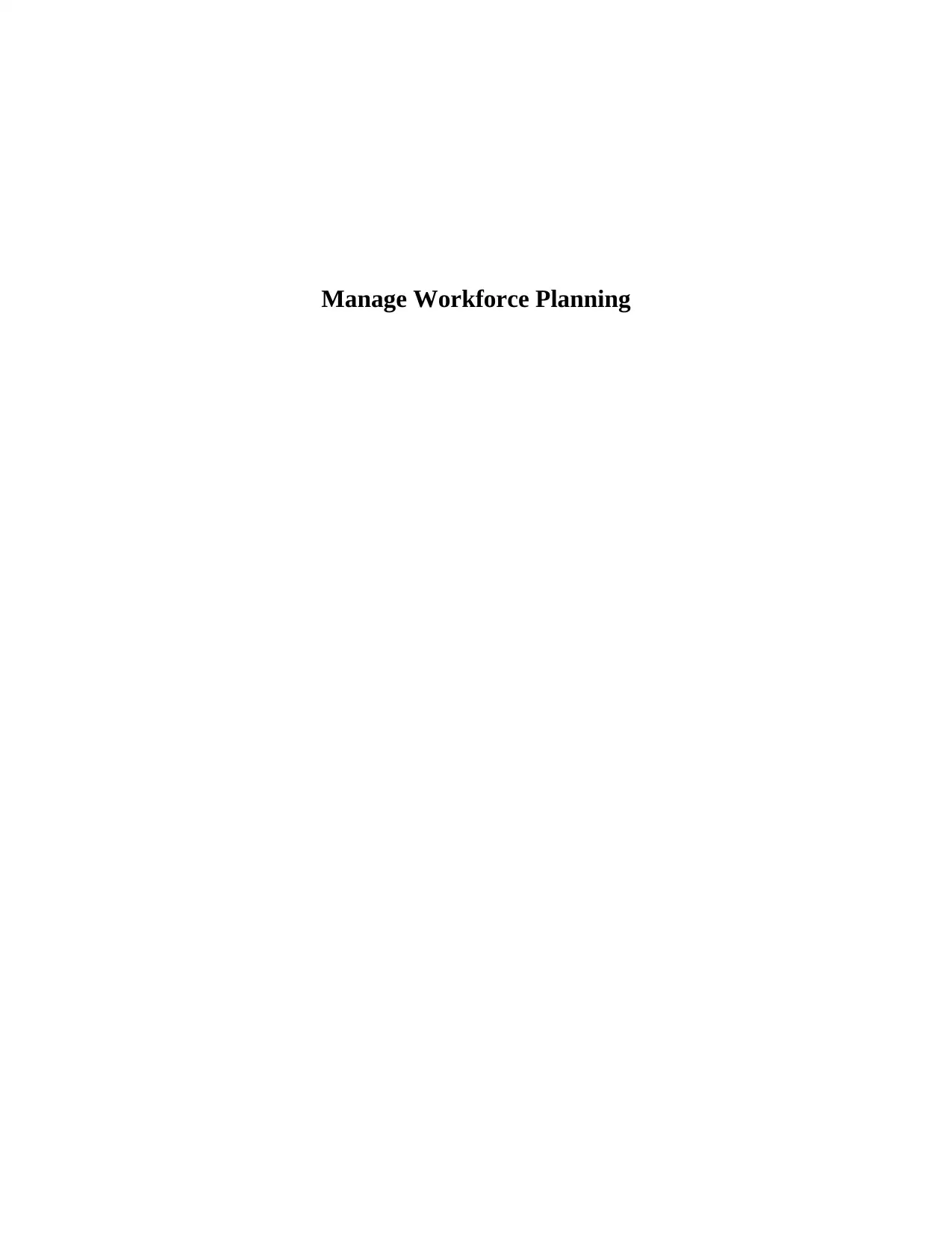
Manage Workforce Planning
Paraphrase This Document
Need a fresh take? Get an instant paraphrase of this document with our AI Paraphraser
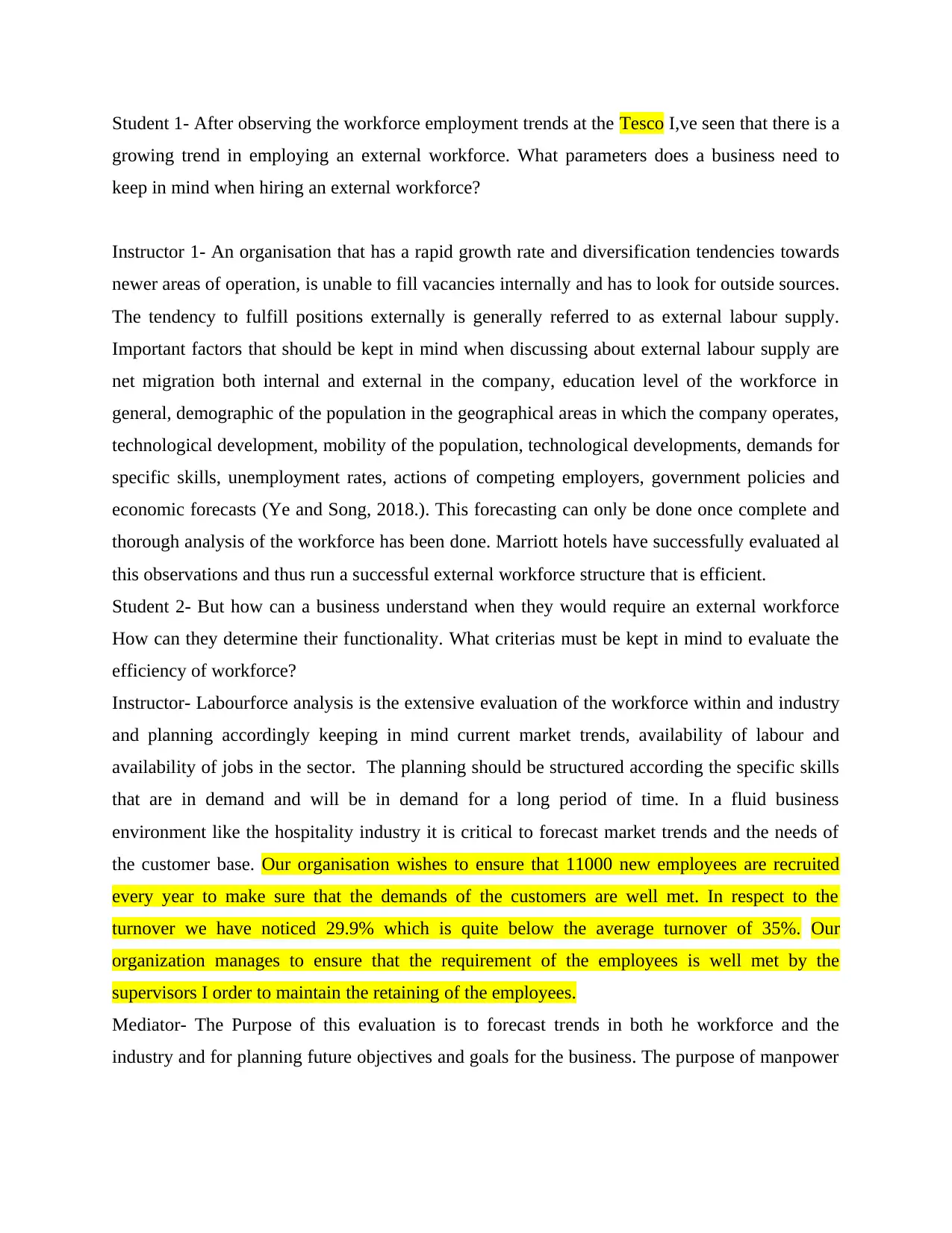
Student 1- After observing the workforce employment trends at the Tesco I,ve seen that there is a
growing trend in employing an external workforce. What parameters does a business need to
keep in mind when hiring an external workforce?
Instructor 1- An organisation that has a rapid growth rate and diversification tendencies towards
newer areas of operation, is unable to fill vacancies internally and has to look for outside sources.
The tendency to fulfill positions externally is generally referred to as external labour supply.
Important factors that should be kept in mind when discussing about external labour supply are
net migration both internal and external in the company, education level of the workforce in
general, demographic of the population in the geographical areas in which the company operates,
technological development, mobility of the population, technological developments, demands for
specific skills, unemployment rates, actions of competing employers, government policies and
economic forecasts (Ye and Song, 2018.). This forecasting can only be done once complete and
thorough analysis of the workforce has been done. Marriott hotels have successfully evaluated al
this observations and thus run a successful external workforce structure that is efficient.
Student 2- But how can a business understand when they would require an external workforce
How can they determine their functionality. What criterias must be kept in mind to evaluate the
efficiency of workforce?
Instructor- Labourforce analysis is the extensive evaluation of the workforce within and industry
and planning accordingly keeping in mind current market trends, availability of labour and
availability of jobs in the sector. The planning should be structured according the specific skills
that are in demand and will be in demand for a long period of time. In a fluid business
environment like the hospitality industry it is critical to forecast market trends and the needs of
the customer base. Our organisation wishes to ensure that 11000 new employees are recruited
every year to make sure that the demands of the customers are well met. In respect to the
turnover we have noticed 29.9% which is quite below the average turnover of 35%. Our
organization manages to ensure that the requirement of the employees is well met by the
supervisors I order to maintain the retaining of the employees.
Mediator- The Purpose of this evaluation is to forecast trends in both he workforce and the
industry and for planning future objectives and goals for the business. The purpose of manpower
growing trend in employing an external workforce. What parameters does a business need to
keep in mind when hiring an external workforce?
Instructor 1- An organisation that has a rapid growth rate and diversification tendencies towards
newer areas of operation, is unable to fill vacancies internally and has to look for outside sources.
The tendency to fulfill positions externally is generally referred to as external labour supply.
Important factors that should be kept in mind when discussing about external labour supply are
net migration both internal and external in the company, education level of the workforce in
general, demographic of the population in the geographical areas in which the company operates,
technological development, mobility of the population, technological developments, demands for
specific skills, unemployment rates, actions of competing employers, government policies and
economic forecasts (Ye and Song, 2018.). This forecasting can only be done once complete and
thorough analysis of the workforce has been done. Marriott hotels have successfully evaluated al
this observations and thus run a successful external workforce structure that is efficient.
Student 2- But how can a business understand when they would require an external workforce
How can they determine their functionality. What criterias must be kept in mind to evaluate the
efficiency of workforce?
Instructor- Labourforce analysis is the extensive evaluation of the workforce within and industry
and planning accordingly keeping in mind current market trends, availability of labour and
availability of jobs in the sector. The planning should be structured according the specific skills
that are in demand and will be in demand for a long period of time. In a fluid business
environment like the hospitality industry it is critical to forecast market trends and the needs of
the customer base. Our organisation wishes to ensure that 11000 new employees are recruited
every year to make sure that the demands of the customers are well met. In respect to the
turnover we have noticed 29.9% which is quite below the average turnover of 35%. Our
organization manages to ensure that the requirement of the employees is well met by the
supervisors I order to maintain the retaining of the employees.
Mediator- The Purpose of this evaluation is to forecast trends in both he workforce and the
industry and for planning future objectives and goals for the business. The purpose of manpower
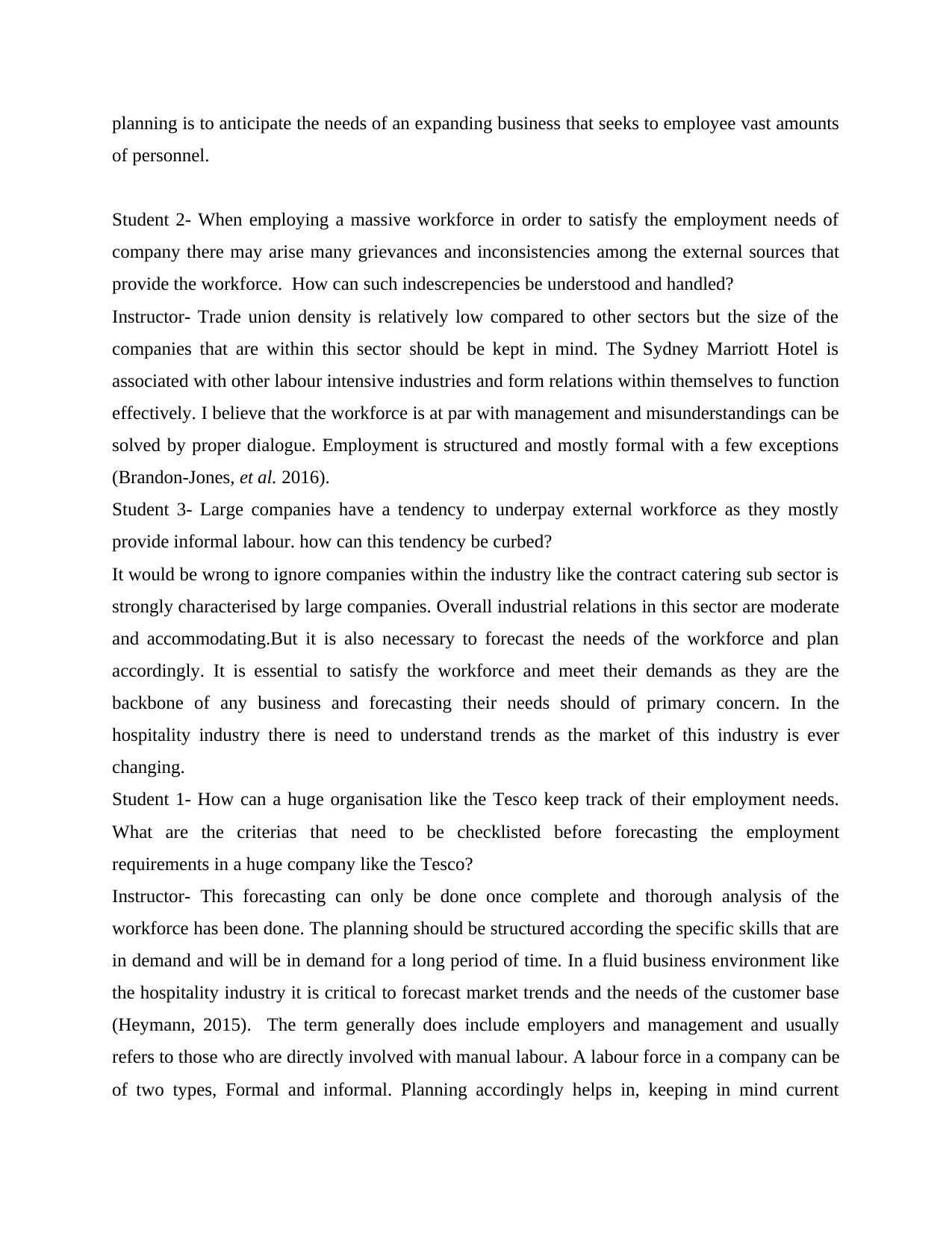
planning is to anticipate the needs of an expanding business that seeks to employee vast amounts
of personnel.
Student 2- When employing a massive workforce in order to satisfy the employment needs of
company there may arise many grievances and inconsistencies among the external sources that
provide the workforce. How can such indescrepencies be understood and handled?
Instructor- Trade union density is relatively low compared to other sectors but the size of the
companies that are within this sector should be kept in mind. The Sydney Marriott Hotel is
associated with other labour intensive industries and form relations within themselves to function
effectively. I believe that the workforce is at par with management and misunderstandings can be
solved by proper dialogue. Employment is structured and mostly formal with a few exceptions
(Brandon-Jones, et al. 2016).
Student 3- Large companies have a tendency to underpay external workforce as they mostly
provide informal labour. how can this tendency be curbed?
It would be wrong to ignore companies within the industry like the contract catering sub sector is
strongly characterised by large companies. Overall industrial relations in this sector are moderate
and accommodating.But it is also necessary to forecast the needs of the workforce and plan
accordingly. It is essential to satisfy the workforce and meet their demands as they are the
backbone of any business and forecasting their needs should of primary concern. In the
hospitality industry there is need to understand trends as the market of this industry is ever
changing.
Student 1- How can a huge organisation like the Tesco keep track of their employment needs.
What are the criterias that need to be checklisted before forecasting the employment
requirements in a huge company like the Tesco?
Instructor- This forecasting can only be done once complete and thorough analysis of the
workforce has been done. The planning should be structured according the specific skills that are
in demand and will be in demand for a long period of time. In a fluid business environment like
the hospitality industry it is critical to forecast market trends and the needs of the customer base
(Heymann, 2015). The term generally does include employers and management and usually
refers to those who are directly involved with manual labour. A labour force in a company can be
of two types, Formal and informal. Planning accordingly helps in, keeping in mind current
of personnel.
Student 2- When employing a massive workforce in order to satisfy the employment needs of
company there may arise many grievances and inconsistencies among the external sources that
provide the workforce. How can such indescrepencies be understood and handled?
Instructor- Trade union density is relatively low compared to other sectors but the size of the
companies that are within this sector should be kept in mind. The Sydney Marriott Hotel is
associated with other labour intensive industries and form relations within themselves to function
effectively. I believe that the workforce is at par with management and misunderstandings can be
solved by proper dialogue. Employment is structured and mostly formal with a few exceptions
(Brandon-Jones, et al. 2016).
Student 3- Large companies have a tendency to underpay external workforce as they mostly
provide informal labour. how can this tendency be curbed?
It would be wrong to ignore companies within the industry like the contract catering sub sector is
strongly characterised by large companies. Overall industrial relations in this sector are moderate
and accommodating.But it is also necessary to forecast the needs of the workforce and plan
accordingly. It is essential to satisfy the workforce and meet their demands as they are the
backbone of any business and forecasting their needs should of primary concern. In the
hospitality industry there is need to understand trends as the market of this industry is ever
changing.
Student 1- How can a huge organisation like the Tesco keep track of their employment needs.
What are the criterias that need to be checklisted before forecasting the employment
requirements in a huge company like the Tesco?
Instructor- This forecasting can only be done once complete and thorough analysis of the
workforce has been done. The planning should be structured according the specific skills that are
in demand and will be in demand for a long period of time. In a fluid business environment like
the hospitality industry it is critical to forecast market trends and the needs of the customer base
(Heymann, 2015). The term generally does include employers and management and usually
refers to those who are directly involved with manual labour. A labour force in a company can be
of two types, Formal and informal. Planning accordingly helps in, keeping in mind current
⊘ This is a preview!⊘
Do you want full access?
Subscribe today to unlock all pages.

Trusted by 1+ million students worldwide
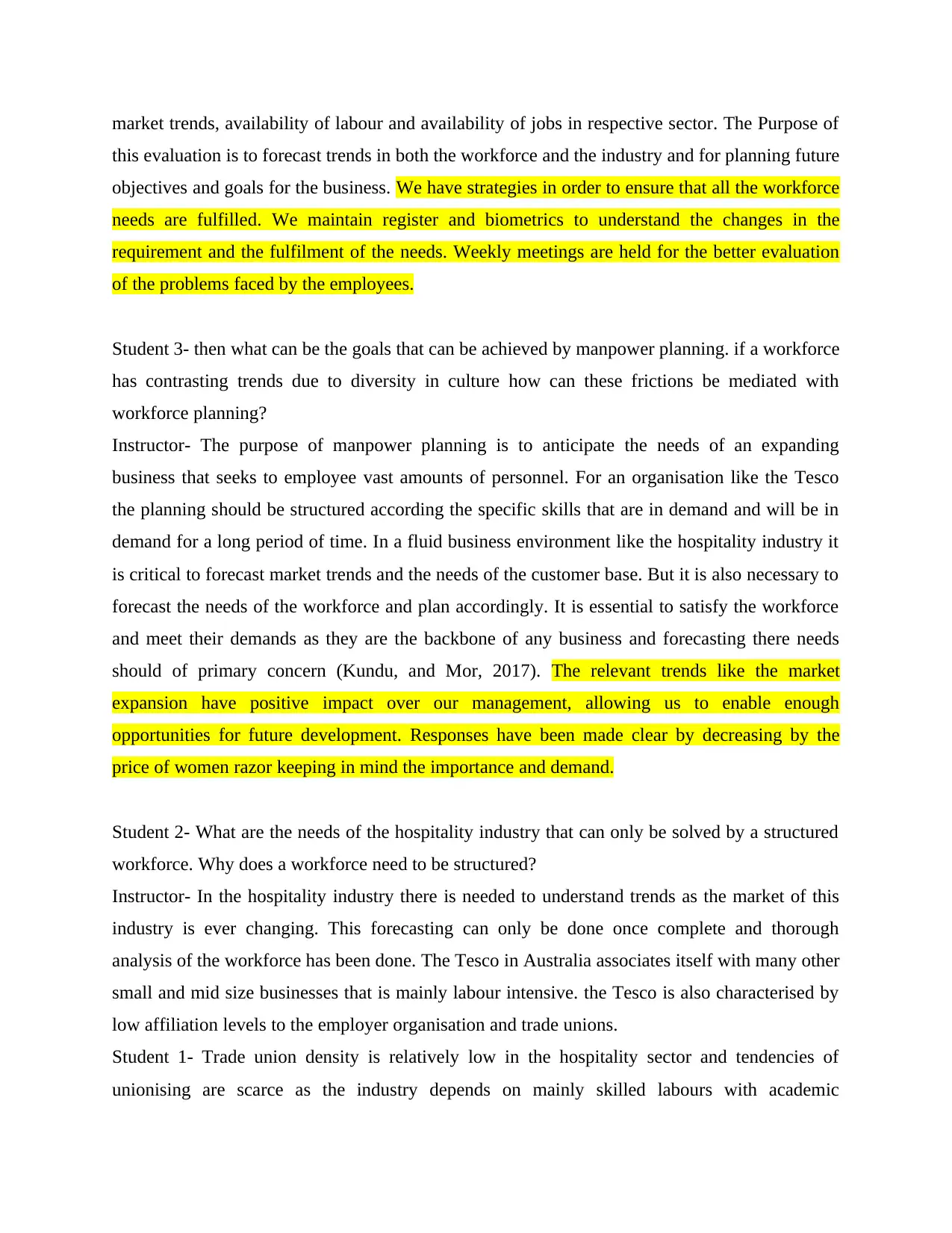
market trends, availability of labour and availability of jobs in respective sector. The Purpose of
this evaluation is to forecast trends in both the workforce and the industry and for planning future
objectives and goals for the business. We have strategies in order to ensure that all the workforce
needs are fulfilled. We maintain register and biometrics to understand the changes in the
requirement and the fulfilment of the needs. Weekly meetings are held for the better evaluation
of the problems faced by the employees.
Student 3- then what can be the goals that can be achieved by manpower planning. if a workforce
has contrasting trends due to diversity in culture how can these frictions be mediated with
workforce planning?
Instructor- The purpose of manpower planning is to anticipate the needs of an expanding
business that seeks to employee vast amounts of personnel. For an organisation like the Tesco
the planning should be structured according the specific skills that are in demand and will be in
demand for a long period of time. In a fluid business environment like the hospitality industry it
is critical to forecast market trends and the needs of the customer base. But it is also necessary to
forecast the needs of the workforce and plan accordingly. It is essential to satisfy the workforce
and meet their demands as they are the backbone of any business and forecasting there needs
should of primary concern (Kundu, and Mor, 2017). The relevant trends like the market
expansion have positive impact over our management, allowing us to enable enough
opportunities for future development. Responses have been made clear by decreasing by the
price of women razor keeping in mind the importance and demand.
Student 2- What are the needs of the hospitality industry that can only be solved by a structured
workforce. Why does a workforce need to be structured?
Instructor- In the hospitality industry there is needed to understand trends as the market of this
industry is ever changing. This forecasting can only be done once complete and thorough
analysis of the workforce has been done. The Tesco in Australia associates itself with many other
small and mid size businesses that is mainly labour intensive. the Tesco is also characterised by
low affiliation levels to the employer organisation and trade unions.
Student 1- Trade union density is relatively low in the hospitality sector and tendencies of
unionising are scarce as the industry depends on mainly skilled labours with academic
this evaluation is to forecast trends in both the workforce and the industry and for planning future
objectives and goals for the business. We have strategies in order to ensure that all the workforce
needs are fulfilled. We maintain register and biometrics to understand the changes in the
requirement and the fulfilment of the needs. Weekly meetings are held for the better evaluation
of the problems faced by the employees.
Student 3- then what can be the goals that can be achieved by manpower planning. if a workforce
has contrasting trends due to diversity in culture how can these frictions be mediated with
workforce planning?
Instructor- The purpose of manpower planning is to anticipate the needs of an expanding
business that seeks to employee vast amounts of personnel. For an organisation like the Tesco
the planning should be structured according the specific skills that are in demand and will be in
demand for a long period of time. In a fluid business environment like the hospitality industry it
is critical to forecast market trends and the needs of the customer base. But it is also necessary to
forecast the needs of the workforce and plan accordingly. It is essential to satisfy the workforce
and meet their demands as they are the backbone of any business and forecasting there needs
should of primary concern (Kundu, and Mor, 2017). The relevant trends like the market
expansion have positive impact over our management, allowing us to enable enough
opportunities for future development. Responses have been made clear by decreasing by the
price of women razor keeping in mind the importance and demand.
Student 2- What are the needs of the hospitality industry that can only be solved by a structured
workforce. Why does a workforce need to be structured?
Instructor- In the hospitality industry there is needed to understand trends as the market of this
industry is ever changing. This forecasting can only be done once complete and thorough
analysis of the workforce has been done. The Tesco in Australia associates itself with many other
small and mid size businesses that is mainly labour intensive. the Tesco is also characterised by
low affiliation levels to the employer organisation and trade unions.
Student 1- Trade union density is relatively low in the hospitality sector and tendencies of
unionising are scarce as the industry depends on mainly skilled labours with academic
Paraphrase This Document
Need a fresh take? Get an instant paraphrase of this document with our AI Paraphraser
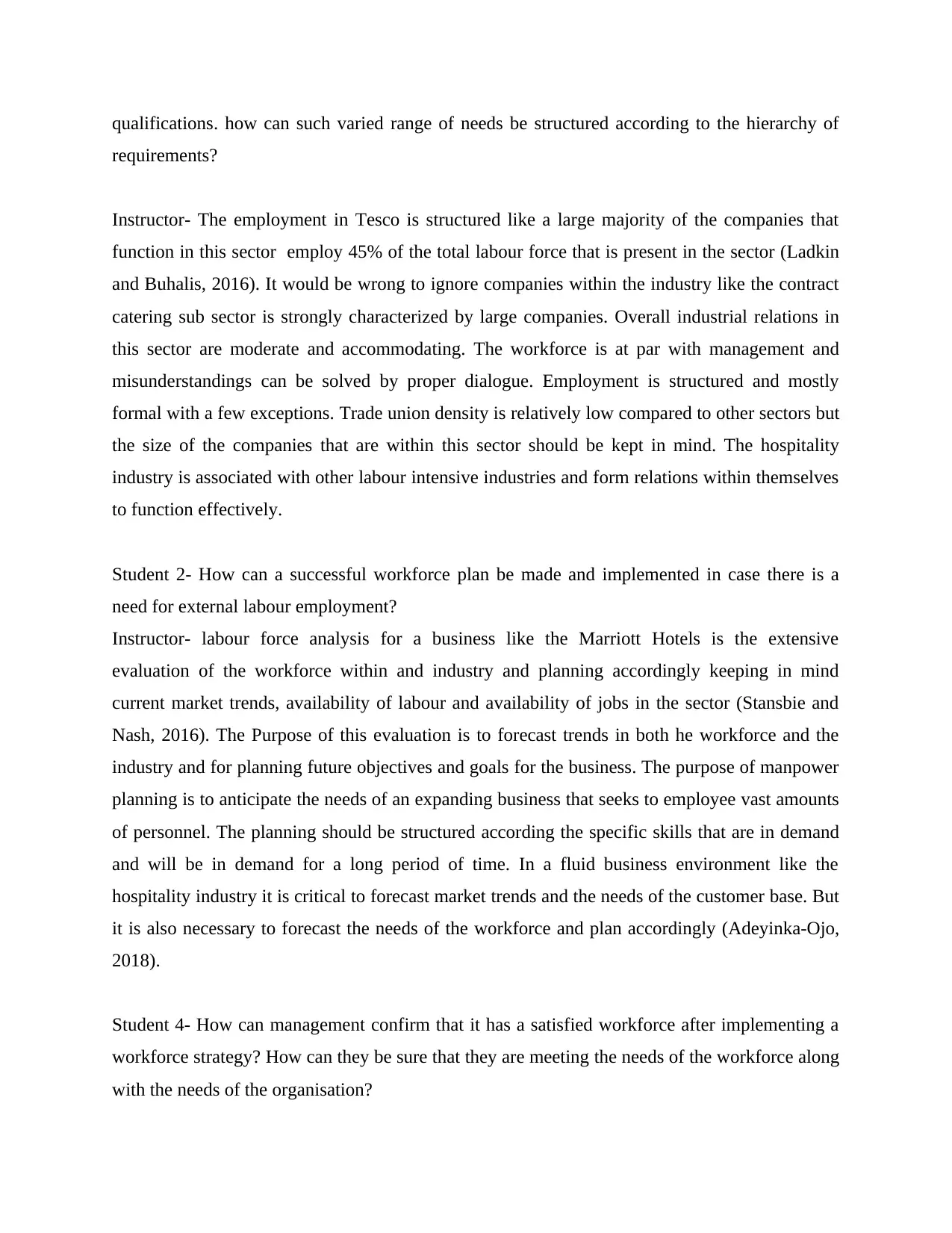
qualifications. how can such varied range of needs be structured according to the hierarchy of
requirements?
Instructor- The employment in Tesco is structured like a large majority of the companies that
function in this sector employ 45% of the total labour force that is present in the sector (Ladkin
and Buhalis, 2016). It would be wrong to ignore companies within the industry like the contract
catering sub sector is strongly characterized by large companies. Overall industrial relations in
this sector are moderate and accommodating. The workforce is at par with management and
misunderstandings can be solved by proper dialogue. Employment is structured and mostly
formal with a few exceptions. Trade union density is relatively low compared to other sectors but
the size of the companies that are within this sector should be kept in mind. The hospitality
industry is associated with other labour intensive industries and form relations within themselves
to function effectively.
Student 2- How can a successful workforce plan be made and implemented in case there is a
need for external labour employment?
Instructor- labour force analysis for a business like the Marriott Hotels is the extensive
evaluation of the workforce within and industry and planning accordingly keeping in mind
current market trends, availability of labour and availability of jobs in the sector (Stansbie and
Nash, 2016). The Purpose of this evaluation is to forecast trends in both he workforce and the
industry and for planning future objectives and goals for the business. The purpose of manpower
planning is to anticipate the needs of an expanding business that seeks to employee vast amounts
of personnel. The planning should be structured according the specific skills that are in demand
and will be in demand for a long period of time. In a fluid business environment like the
hospitality industry it is critical to forecast market trends and the needs of the customer base. But
it is also necessary to forecast the needs of the workforce and plan accordingly (Adeyinka-Ojo,
2018).
Student 4- How can management confirm that it has a satisfied workforce after implementing a
workforce strategy? How can they be sure that they are meeting the needs of the workforce along
with the needs of the organisation?
requirements?
Instructor- The employment in Tesco is structured like a large majority of the companies that
function in this sector employ 45% of the total labour force that is present in the sector (Ladkin
and Buhalis, 2016). It would be wrong to ignore companies within the industry like the contract
catering sub sector is strongly characterized by large companies. Overall industrial relations in
this sector are moderate and accommodating. The workforce is at par with management and
misunderstandings can be solved by proper dialogue. Employment is structured and mostly
formal with a few exceptions. Trade union density is relatively low compared to other sectors but
the size of the companies that are within this sector should be kept in mind. The hospitality
industry is associated with other labour intensive industries and form relations within themselves
to function effectively.
Student 2- How can a successful workforce plan be made and implemented in case there is a
need for external labour employment?
Instructor- labour force analysis for a business like the Marriott Hotels is the extensive
evaluation of the workforce within and industry and planning accordingly keeping in mind
current market trends, availability of labour and availability of jobs in the sector (Stansbie and
Nash, 2016). The Purpose of this evaluation is to forecast trends in both he workforce and the
industry and for planning future objectives and goals for the business. The purpose of manpower
planning is to anticipate the needs of an expanding business that seeks to employee vast amounts
of personnel. The planning should be structured according the specific skills that are in demand
and will be in demand for a long period of time. In a fluid business environment like the
hospitality industry it is critical to forecast market trends and the needs of the customer base. But
it is also necessary to forecast the needs of the workforce and plan accordingly (Adeyinka-Ojo,
2018).
Student 4- How can management confirm that it has a satisfied workforce after implementing a
workforce strategy? How can they be sure that they are meeting the needs of the workforce along
with the needs of the organisation?
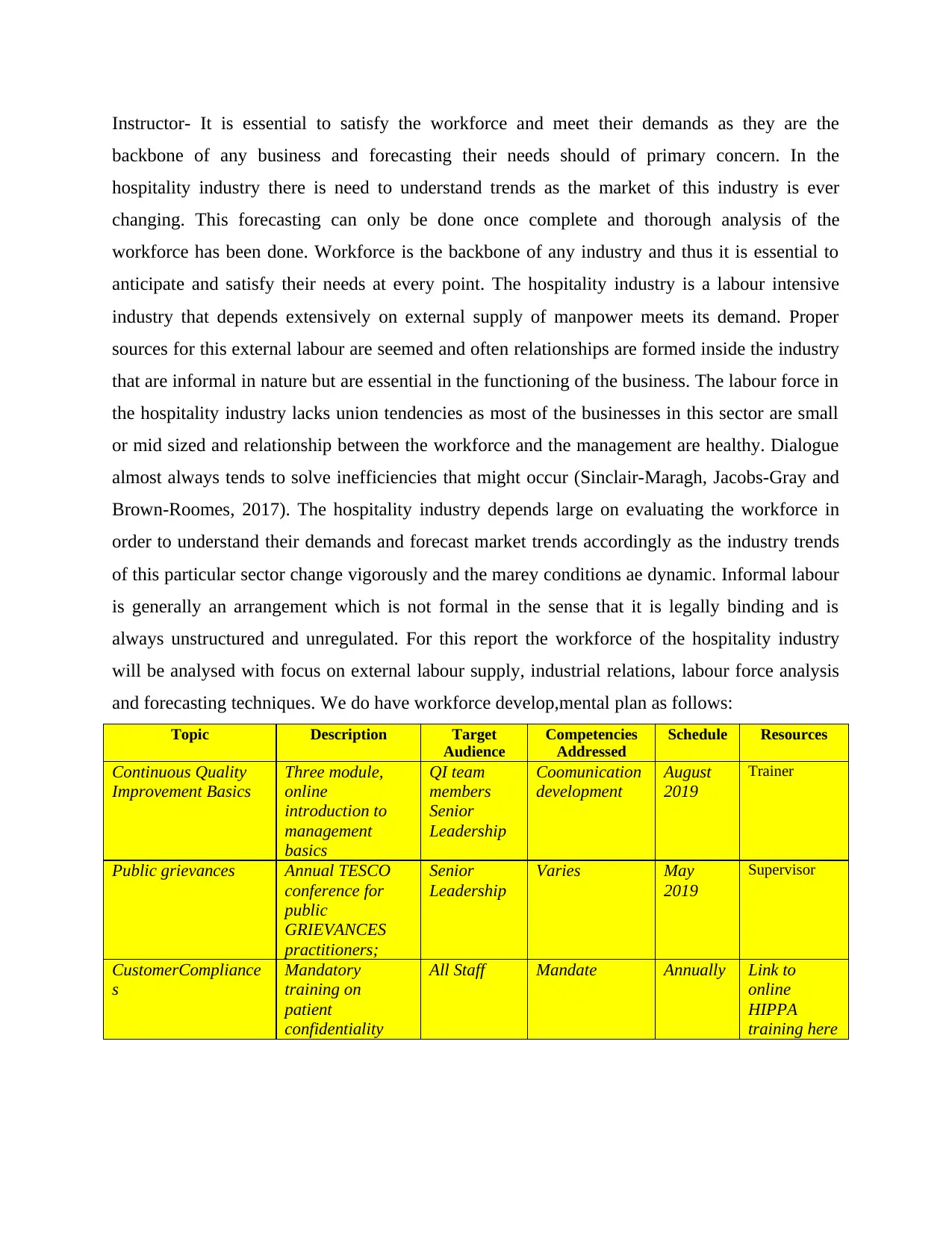
Instructor- It is essential to satisfy the workforce and meet their demands as they are the
backbone of any business and forecasting their needs should of primary concern. In the
hospitality industry there is need to understand trends as the market of this industry is ever
changing. This forecasting can only be done once complete and thorough analysis of the
workforce has been done. Workforce is the backbone of any industry and thus it is essential to
anticipate and satisfy their needs at every point. The hospitality industry is a labour intensive
industry that depends extensively on external supply of manpower meets its demand. Proper
sources for this external labour are seemed and often relationships are formed inside the industry
that are informal in nature but are essential in the functioning of the business. The labour force in
the hospitality industry lacks union tendencies as most of the businesses in this sector are small
or mid sized and relationship between the workforce and the management are healthy. Dialogue
almost always tends to solve inefficiencies that might occur (Sinclair-Maragh, Jacobs-Gray and
Brown-Roomes, 2017). The hospitality industry depends large on evaluating the workforce in
order to understand their demands and forecast market trends accordingly as the industry trends
of this particular sector change vigorously and the marey conditions ae dynamic. Informal labour
is generally an arrangement which is not formal in the sense that it is legally binding and is
always unstructured and unregulated. For this report the workforce of the hospitality industry
will be analysed with focus on external labour supply, industrial relations, labour force analysis
and forecasting techniques. We do have workforce develop,mental plan as follows:
Topic Description Target
Audience
Competencies
Addressed
Schedule Resources
Continuous Quality
Improvement Basics
Three module,
online
introduction to
management
basics
QI team
members
Senior
Leadership
Coomunication
development
August
2019
Trainer
Public grievances Annual TESCO
conference for
public
GRIEVANCES
practitioners;
Senior
Leadership
Varies May
2019
Supervisor
CustomerCompliance
s
Mandatory
training on
patient
confidentiality
All Staff Mandate Annually Link to
online
HIPPA
training here
backbone of any business and forecasting their needs should of primary concern. In the
hospitality industry there is need to understand trends as the market of this industry is ever
changing. This forecasting can only be done once complete and thorough analysis of the
workforce has been done. Workforce is the backbone of any industry and thus it is essential to
anticipate and satisfy their needs at every point. The hospitality industry is a labour intensive
industry that depends extensively on external supply of manpower meets its demand. Proper
sources for this external labour are seemed and often relationships are formed inside the industry
that are informal in nature but are essential in the functioning of the business. The labour force in
the hospitality industry lacks union tendencies as most of the businesses in this sector are small
or mid sized and relationship between the workforce and the management are healthy. Dialogue
almost always tends to solve inefficiencies that might occur (Sinclair-Maragh, Jacobs-Gray and
Brown-Roomes, 2017). The hospitality industry depends large on evaluating the workforce in
order to understand their demands and forecast market trends accordingly as the industry trends
of this particular sector change vigorously and the marey conditions ae dynamic. Informal labour
is generally an arrangement which is not formal in the sense that it is legally binding and is
always unstructured and unregulated. For this report the workforce of the hospitality industry
will be analysed with focus on external labour supply, industrial relations, labour force analysis
and forecasting techniques. We do have workforce develop,mental plan as follows:
Topic Description Target
Audience
Competencies
Addressed
Schedule Resources
Continuous Quality
Improvement Basics
Three module,
online
introduction to
management
basics
QI team
members
Senior
Leadership
Coomunication
development
August
2019
Trainer
Public grievances Annual TESCO
conference for
public
GRIEVANCES
practitioners;
Senior
Leadership
Varies May
2019
Supervisor
CustomerCompliance
s
Mandatory
training on
patient
confidentiality
All Staff Mandate Annually Link to
online
HIPPA
training here
⊘ This is a preview!⊘
Do you want full access?
Subscribe today to unlock all pages.

Trusted by 1+ million students worldwide
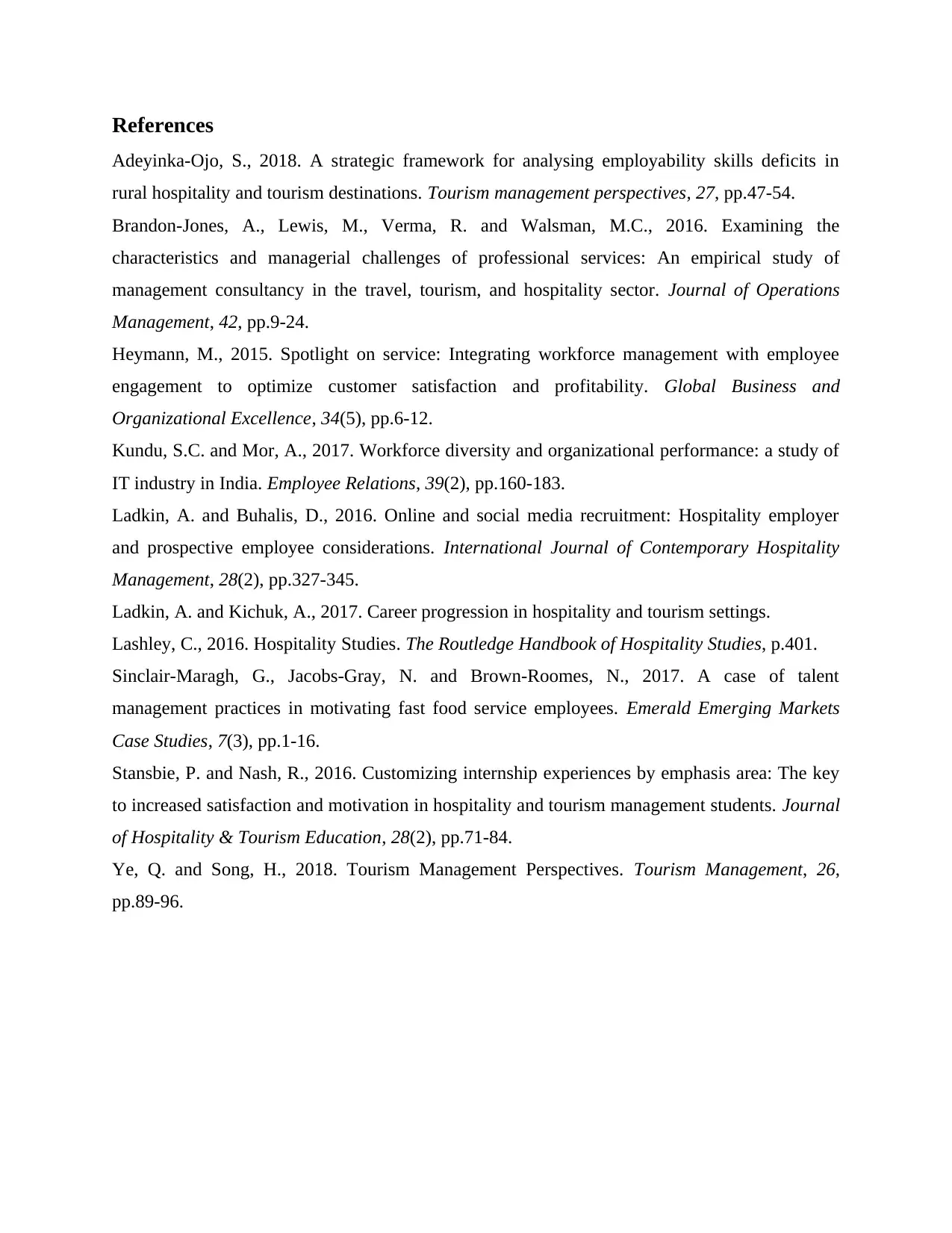
References
Adeyinka-Ojo, S., 2018. A strategic framework for analysing employability skills deficits in
rural hospitality and tourism destinations. Tourism management perspectives, 27, pp.47-54.
Brandon-Jones, A., Lewis, M., Verma, R. and Walsman, M.C., 2016. Examining the
characteristics and managerial challenges of professional services: An empirical study of
management consultancy in the travel, tourism, and hospitality sector. Journal of Operations
Management, 42, pp.9-24.
Heymann, M., 2015. Spotlight on service: Integrating workforce management with employee
engagement to optimize customer satisfaction and profitability. Global Business and
Organizational Excellence, 34(5), pp.6-12.
Kundu, S.C. and Mor, A., 2017. Workforce diversity and organizational performance: a study of
IT industry in India. Employee Relations, 39(2), pp.160-183.
Ladkin, A. and Buhalis, D., 2016. Online and social media recruitment: Hospitality employer
and prospective employee considerations. International Journal of Contemporary Hospitality
Management, 28(2), pp.327-345.
Ladkin, A. and Kichuk, A., 2017. Career progression in hospitality and tourism settings.
Lashley, C., 2016. Hospitality Studies. The Routledge Handbook of Hospitality Studies, p.401.
Sinclair-Maragh, G., Jacobs-Gray, N. and Brown-Roomes, N., 2017. A case of talent
management practices in motivating fast food service employees. Emerald Emerging Markets
Case Studies, 7(3), pp.1-16.
Stansbie, P. and Nash, R., 2016. Customizing internship experiences by emphasis area: The key
to increased satisfaction and motivation in hospitality and tourism management students. Journal
of Hospitality & Tourism Education, 28(2), pp.71-84.
Ye, Q. and Song, H., 2018. Tourism Management Perspectives. Tourism Management, 26,
pp.89-96.
Adeyinka-Ojo, S., 2018. A strategic framework for analysing employability skills deficits in
rural hospitality and tourism destinations. Tourism management perspectives, 27, pp.47-54.
Brandon-Jones, A., Lewis, M., Verma, R. and Walsman, M.C., 2016. Examining the
characteristics and managerial challenges of professional services: An empirical study of
management consultancy in the travel, tourism, and hospitality sector. Journal of Operations
Management, 42, pp.9-24.
Heymann, M., 2015. Spotlight on service: Integrating workforce management with employee
engagement to optimize customer satisfaction and profitability. Global Business and
Organizational Excellence, 34(5), pp.6-12.
Kundu, S.C. and Mor, A., 2017. Workforce diversity and organizational performance: a study of
IT industry in India. Employee Relations, 39(2), pp.160-183.
Ladkin, A. and Buhalis, D., 2016. Online and social media recruitment: Hospitality employer
and prospective employee considerations. International Journal of Contemporary Hospitality
Management, 28(2), pp.327-345.
Ladkin, A. and Kichuk, A., 2017. Career progression in hospitality and tourism settings.
Lashley, C., 2016. Hospitality Studies. The Routledge Handbook of Hospitality Studies, p.401.
Sinclair-Maragh, G., Jacobs-Gray, N. and Brown-Roomes, N., 2017. A case of talent
management practices in motivating fast food service employees. Emerald Emerging Markets
Case Studies, 7(3), pp.1-16.
Stansbie, P. and Nash, R., 2016. Customizing internship experiences by emphasis area: The key
to increased satisfaction and motivation in hospitality and tourism management students. Journal
of Hospitality & Tourism Education, 28(2), pp.71-84.
Ye, Q. and Song, H., 2018. Tourism Management Perspectives. Tourism Management, 26,
pp.89-96.
1 out of 7
Related Documents
Your All-in-One AI-Powered Toolkit for Academic Success.
+13062052269
info@desklib.com
Available 24*7 on WhatsApp / Email
![[object Object]](/_next/static/media/star-bottom.7253800d.svg)
Unlock your academic potential
Copyright © 2020–2025 A2Z Services. All Rights Reserved. Developed and managed by ZUCOL.





